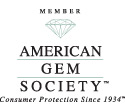Gemology 101
- Overall Quality
- Color
- Cut
- Clarity
- Phenomenal Gems
- Opals
- Enhancements
- Country of Origin
- Photography
- The Mardon Guarantee
Overall Quality
Overview- The Mardon Colored Gem Grading System is an integrated approach, based on the GIA Color Description System, the Gem Guide wholesale pricing book, and our own research plus three decades of experience in the gem business. Each gem in our Gallery of Gems has a full grading report.
In our appraisal and grading practice, we follow the general structure found in the Gem Guide wholesale gem pricing book published bimonthly by Richard Drucker, Gemworld International Inc., because we find it to be an accurate, reliable and consistent source of market based price data for colored gemstones.
Since price follows grade, and vice versa, our Overall Quality Grades reflect our opinion of the value and relative position of a gem within the market place.
For a more complete explanation of colored stone grading, please review the sections on color, cut, and clarity in the menu to the right.
Overall Quality Grade
We grade the overall quality of the gem by combining the effects of color, cut, and clarity, as well as rarity into a description and score of 1 - 10, 10 being the highest.
Note that some overlap can occur where the number grades meet. A stone could be graded 8 Extra Fine or 8 Fine, depending on various factors, especially rarity and gem species.
Since color accounts for as much as 70% of the stone value, we use the color grade as the initial grade and then apply adjustments for clarity and cut. So, a stone graded 9 for color could have clarity and cut grades of 6 and still be considered Extra Fine.
- 8 - 10: Extra Fine. The best of the best, rarely seen, and never cheap. May have only minute defects in proportions or clarity or cut. The top 5% almost never available set.
- 6 - 8: Fine. These are stones normally considered fine and sold as such in better to high-end jewelry stores. Stones graded 8.5 and above fall into the top 10% of possible quality
- 4 - 6: Good. Quality grades adequate in color and cut. Seen in good to better jewelry stores.
- 1 - 4: Gemstones that fall into this category are what the trade calls "commercial".
- Upper commercial, 3 - 4 can include clean stones with decent cut, but pale or less rare or desirable colors in material such as amethyst, aquamarine, garnets, peridot, blue topaz, and other more common gem material.
- Low commercial, 1 - 2 may be highly included, poorly cut, and/or deficient in color.
Please refer to the items on our Gallery of Gems for grading examples.
Relationship of Grades
The integration of Color, Cut, and Clarity grades into our Overall Quality Grade generally follows this matrix, from Gem Guide Color price book, Fall/Winter 2008/2009, p. 10.
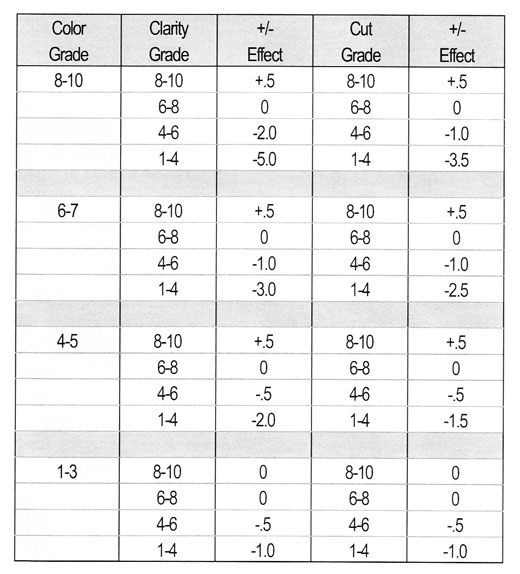
Color
Grading System for Colored Gems-Color
Color is the key factor of colored gems, contributing as much as 70% of the value of the gem, while clarity and cut make up the remaining 30%. The color grade is the most important grade.
Our color grade describes the individual color components of saturation, tone (lightness or darkness), and hue of the gem, in that order, i.e. Vivid Medium Orange-Red, following the descriptive system for color developed by GIA.
We grade each component separately, which are combined for a numerical Color Grade.
Color Grade
We grade the color of a gemstone by combining the three components of color, saturation, tone, and hue with Lighting Effects into a description and score of 1 - 10, 10 being highest.
Note that some overlap can occur where the number grades meet. A stone could be graded 8 Extra Fine or 8 Fine, depending on various factors, especially rarity and gem species.
The Color Grade follows what color scientists call color gamut limits where each hue reaches its optimum saturation at a certain defined tone. The gamut limits vary for each hue. Yellows reaches their brightest-richest saturation at ~ 20-30% tone, oranges ~ 20-40%, greens at ~ 60-75% tone, reds at 70-80%, and blues and purples at 75-85%.
The most desirable and valuable colored gems closely follow these gamut limits. Pure hues are favored over mixed hues and are more rare in nature. The presence and percentage of secondary hues and/or masks will affect the grade. Rare and unusual colors may receive a higher grade if the color is desirable.
- 8 - 10: Extra Fine. The best of the best, rarely seen, and never cheap. Vivid pure colors of the appropriate tone
- 6 - 8: Fine. The color is strong and bright to very bright, tone is in ideal range, may have desirable secondary hue, slight lighting effects
- 4 - 6: Good. Color is moderately strong to bright, tone may be slightly dark or light, slightly masked by gray or brown overtone, secondary hue and moderate lighting affects may be present
- 4 - 1: Commercial. Gemstones that fall into this category have noticeable to strong overtones which mask the color and are often too dark or light in tone
Please refer to the items on our Gallery of Gems for grading examples.
Saturation
A color's strength or intensity is graded 1-6.
- 1 - brownish or grayish colors
- 2 - slightly brownish or grayish colors
- 3 - very slightly brownish or grayish colors
- 4 - moderately strong colors (no trace of brown or gray)
- 5 - strong colors
- 6 - vivid colors
Tone
Lightness to darkness is graded 2-8. In practice, only levels 2 through 8 apply to transparent colored stones-tones lighter or darker are nearly impossible for the human eye to detect. The more valuable gems tend to fall within medium light to medium dark tones and higher saturations.
- 0 - colorless / white
- 2 - very light
- 3 - light
- 4 - medium light
- 5 - medium
- 6 - medium dark
- 7 - dark
- 8 - very dark
- 9-10 - black
Hue
The color names come from the standard color wheel. Note that the dominant color is capitalized. When both are capitalized and separated by a dash, each color has equal weight. The color names we use are:
- Colorless
- Black
- Gray
- Brown
- yellowish Brown
- orangey Brown
- greenish Brown
- pinkish Orange
- Orange-Pink
- orangey Pink
- slightly orangey Pink
- Pink
- purplish Pink
- Pink-Purple
- pinkish Purple
- Purple
- reddish Purple
- Purple-Red
- strongly purplish Red
- slightly purplish Red
- Red
- orangey Red
- Red-Orange
- reddish Orange
- Orange
- yellowish Orange
- Orange-Yellow
- orangey Yellow
- Yellow
- greenish Yellow
- Yellow-Green
- strongly yellowish Green
- yellowish Green
- slightly yellowish green
- Green
- very slightly bluish Green
- bluish Green
- very strongly bluish Green
- Blue-Green
- very strongly greenish Blue
- greenish Blue
- very slightly greenish Blue
- Blue
- violetish Blue
- bluish Violet
- Violet
- violetish Purple
Important Notes on Hue: The color descriptions of hue in our grading system, as well as the GIA color system are loosely based on Munsell color system (http://en.wikipedia.org/wiki/Munsell) with modifications based on natural distributions of hue that are found in gems.
The pink hues are not listed in the GIA descriptive system. In the gem trade, fancy sapphires such as Padparadscha are described in terms of pink and orange, even on GIA Identification reports, and some hues of tourmaline, morganite, and diamond are also named pink. Fancy pink sapphires often have overtones of purple, so we've included purplish Pink, etc.
The GIA color description system uses brown and gray primarily as modifiers or masks of color saturation. In nature however, we see many gems that can best be described as Brown or Gray being the dominant color, such as yellowish Brown, orangey Brown, bluish Gray, etc. Brown colors can show different levels of richness or saturation with overtones of yellow, orange, or red. Gray colors have overtones from the cool side of the spectrum. We use such hue descriptions where appropriate.
Lighting Effects
The interaction of light with the color of gems and the human eye is very complex. Changes in lighting will cause changes in the perceived color of gemstones. One primary factor is color temperature of the light, as expressed by the Kelvin scale,
- http://en.wikipedia.org/wiki/Color_temperature,
- http://en.wikipedia.org/wiki/Kelvin#Color_temperature
Different light sources produce light with different color temperatures. The traditional standard by which gems are graded is north daylight at noon (5500-6000Kelvin), which is a midrange white light.
The sun produces light at different color temperatures at different times of the day. Filtering agents in the atmosphere, such as pollution, fog, etc, also affect color temperature and our color perception. Natural light in the tropics is very different than that in the temperate and arctic zones. A good rule of thumb is to view a gem in different types of light whenever possible, or to view it with a comparison stone you are familiar with.
Some gems like sapphire, ruby and emerald may lose color value when the lighting environment changes. Incandescent light causes red stones like ruby to look better but sapphires worse. Known as "bleeding", the gem literally looses some of its tone and saturation.
Other gems such as tourmaline and garnet may exhibit a gray or brown mask in incandescent lighting, or the primary or secondary hues may change. Many gems appear to darken when they are set into jewelry, sometimes with beneficial effect, sometimes with negative consequences.
Strongly pleochroic gems are more prone to changes in appearance, since entirely different colors are seen along different axes of the stone ( http://en.wikipedia.org/wiki/Pleochroism). Good cutting can minimize these effects.
A very fine gem holds its color and beauty when the lighting environment changes. If changes occur in color that noticeably or negatively affect beauty, it is considered in the Color Grade and will be noted in the Lighting Effects.
Cut
Grading System for Colored Gems-Cut
Our cut grade is a combination of brilliance, proportions and finish. Stones are rated according to a standard scale of Excellent, Very Good, Good, Fair, or Poor, with numerical equivalents 1 - 10.
Cut Grade
We grade the cut of a gemstone by combining brilliance, proportions, and finish grades into a description and score from 1-10, 10 being highest.
Note that some overlap can occur where the number grades meet. A stone could be graded 8 Extra Fine or 8 Fine, depending on various factors, especially rarity and gem species.
8-10: Excellent. - Compares to Gem Guide Extra Fine
- No variations that reduce beauty or practicality
- Brilliance 75% + face up
- Minute variations in proportion symmetry
- Attractive face up outline, length to width ratio
- Acceptable bulge, girdle thickness, table size
- Excellent finish
6-8: Very Good. - Gem Guide Fine
- Minor variations that have slight effect on beauty, brilliance and symmetry
- Brilliance 60-75% face up
- Minor variations in proportion symmetry, face-up outline, profile
- Very good finish
4-6: Good. - Gem Guide Good
- Minor variations that have slight to moderate effect on beauty, brilliance and symmetry, but appearance of gem is acceptable
- Brilliance 40-60% face up
- Finish may have noticeable imperfections
2-4: Fair. - Gem Guide Middle to Upper commercial
- Noticeable variations, moderate to major effect on beauty, brilliance and symmetry
- Brilliance 25-40% face up
1-2: Poor. - Gem Guide Middle to Lowest commercial
- Noticeable variations, major effect on beauty, brilliance and symmetry
- Brilliance > 25% face up, color often appears opaque or dull
Please refer to the items on our Gallery of Gems for grading examples.
Brilliance Grading
We visually evaluate of the overall light return of the gemstone. The amount of brilliance is much lower for color than for diamond- colored stones rarely achieve an excellent brilliance grade.
- Brilliance Grade
- Excellent = 75% +
- Very Good = 60 - 75%
- Good = 40 - 60 %
- Fair = 25 - 40%
- Poor = = 25%
Proportion Grading
We divide into sub-grades for Face-up proportions and Profile proportions. Face up is more important and considers symmetry and appeal because that is the view we see most often in jewelry.
Face-up Proportions
Face-up symmetry flaws are non-symmetrical shapes,uneven sides or elements.
Face-up appeal flaws are misshapen or poorly proportioned elements that catch the eye.
- Face-up Proportion Grade: we combine and grade these specific factors to the standard scale with symmetry carrying the most weight.
-
- Excellent -- minute variations from ideal
- Very Good - minor
- Good - noticeable
- Fair - obvious
- Poor - prominent
Profile Proportion Grade
The Profile Proportion Grade evaluates profile symmetry, pavilion bulge, table size, and girdle thickness.
Profile symmetry faults are a wavy girdle, uneven, tilted or off center elements
Bulge is the amount of rounding to the pavilion (underside) of a gem. Besides contributing to light leakage, bulge adds extra weight to a gem. Acceptable amounts of bulge are in the 5 to 15% range.
Table size compares table width to the total width-- acceptable ranges are 33 to 67%
Girdle Thickness is a visual judgment described as acceptable or unacceptable.
- Profile Proportion Grade: profile symmetry, beauty, durability, suitability for setting, and extra weight graded to the standard scale.
Finish Grading
We score the polish and facet symmetry flaws as minute, minor, moderate, noticeable, obvious, or prominent, and survey the count and size of facets.
Polishing blemishes are polish lines, scratches, pit, nicks, abrasions.
Facet symmetry flaws are misshapen, irregular, or poorly aligned facets.
Facet survey grades as too few, acceptable, or too many the size and number of facets in relation to the stone's design and size.
- Finish Grade: combines & grades the three factors to the standard scale
Clarity
Grading System for Colored Gems-Clarity
Clarity Nomenclature and Standards: colored gems are clarity graded by the naked eye, rather than at 10X magnification like diamonds. We use a standard overhead daylight fluorescent grading light, with the gem held approximately 10 inches from the eye.
Our clarity grade is a number based on the Gem Guide system (see Grid) combined with these GIA clarity grading terms.
- Eye Clean = ~ equivalent to Flawless grades for diamond
- Slightly Included = ~ equivalent to VVS/VS
- Moderately Included = ~ equivalent to SI
- Heavily Included = ~ equivalent to Imperfect, level 1
- Severely Included = ~ equivalent to Imperfect, level 2 & 3
Clarity Grade
We grade the clarity of a gemstone by combining a description and score of 1-10, 10 being best, with a Clarity Type designation, i.e 6 Fine, Type III. See Clarity Type and Grid.
Note that some overlap can occur where the number grades meet. A stone could be graded 8 Extra Fine or 8 Fine, depending on various factors, especially rarity and gem species.
- 8 - 10: Extra Fine. Eye Clean, all types. Loupe clean to eye clean with minor inclusions.
- 6 - 8: Fine. Slightly included. Type I inclusions difficult to see, Type II somewhat easy to see, Type III may have noticeable inclusions apparent to the eye.
- 4 - 6: Good. Moderately included. Type I inclusions somewhat easy to see, Type II may have noticeable inclusions apparent to the eye.
- 1 - 4: Commercial. Heavily to Severely Included for all types.
Please refer to the items on our Gallery of Gems for grading examples.
Clarity Type
Natural processes of formation are unique to each gem species, so the same clarity standards cannot be applied like a blanket to all the colored stones. An emerald cannot be clarity graded to the same standard as its cousins, aquamarine, morganite, or other beryls-it's not fair to the material and doesn't reflect reality.
GIA has developed a classification of clarity type, so that the different gem varieties can be graded relative to the way they form in nature. The type classification (for transparent gems only) is as follows:
- Type 1: Aquamarine, Morganite, Green Beryl, Heliodor, Chrysoberyl, Spodumene (Kunzite), Blue Topaz, Green Tourmaline, Blue Zircon, Colorless Zircon, and Tanzanite
- Type 2: Andalusite, Apatite, Alexandrite, Corundum (Ruby, Sapphire), Diopside, Feldspar (Moonstone, Sunstone), Garnet, Iolite, Fire Opal, Peridot, Quartz, Spinel, Imperial and Precious Topaz, Tourmaline other than green, and Zircon other than Blue or Colorless
- Type 3: Emerald, Red Beryl, and Watermelon Tourmaline
Grid
This matrix * shows the relationship between the numerical clarity grades and the clarity types. *from The Gem Guide Color price book, Fall/Winter 2008-2009. p. 7.
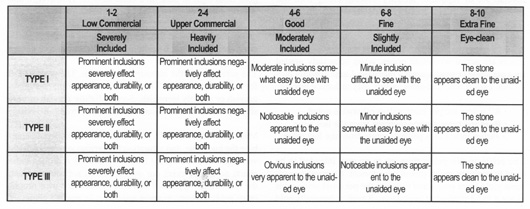
The main differences between grading the clarity types are mainly in the middle ranges, Good 4-6 and Fine 6-8. Extra Fine 8-10 must be eye clean in all types. Any heavily or severely included gem can no higher than 3-4.
Phenomenal Gems
- Intro
- Quality Grade
- Play-of-Color
- Adularescence
- Chatoyance
- Asterism
- Color Change
- Iridescence / Labradorescence
Intro
Light behaves in unique and interesting ways in certain gemstones-- while it dances and sparkles as it is leaps out of the highly transparent diamond, or simmers rich red as it passes thru a fine ruby, the light we see reflected from a fine opal, moonstone, cat's eye, or star sapphire has been transformed by the gem into magical displays that we call optical phenomena.
In gemology, we call these wonderful stones the phenomenal gems (!) and we grade them by evaluating the overall quality and sensory impact of the optical phenomenon present.
Each different optical phenomenon has a specific name and cause, and each presents its own grading challenges. In our appraisal and grading practice, we follow the GIA Gemstone Color Description System and the general grading/pricing structure found in the Gem Guide*
*A wholesale gem pricing book published bimonthly by Richard Drucker, Gemworld International Inc.
Quality Grade
We grade the combined effects of phenomena, body color, transparency, and cut, as well as rarity with a description and score of 1 - 10, 10 being best.
Since the effect of the phenomenon is the dominant feature for grading, we start there and then apply adjustments for the other factors.
- 8 - 10: Extra Fine. The best of the best, rarely seen, and never cheap. Phenomenon is always very bright and strong in all directions, sharp, perfectly oriented and complete. Body color should be top quality for type. May have minor to slight defects in cut, but generally, the cut is superb, reflecting the quality of the material. These stones are often truly unique.
- 6 - 8: Fine. Phenomenon may be bright or very bright, may have minor to slight defects in effect, less than ideal inclusions. Good to Very good body color for type. May have slight defects in cut, should not be too thin or bulky on the bottom.
- 4 - 6: Good. Phenomenon is moderate to bright, some parts of the effect lacking, fair to good orientation, may have many inclusions. Fair to Good body color for type. May have moderate defects in cut.
- 1 - 4: Gemstones that fall into this category are what the trade calls "commercial". Can include stones with weak or incomplete effect, some dull areas face up. Low commercial may be very thick or otherwise poorly cut, weak or dull phenomenon, and/or deficient in color.
Grading Clarity of Phenomenal Gems
Since phenomenal gems are prized for their display of a particular optic phenomenon, clarity grading per se is generally not applicable to these gems, with the exception of color change faceted gems.
Grading Body Color
We grade the overall body color and transparency of many phenomenal gems. The exceptions are mainly opal and color change gems.
The color of star rubies and sapphires and cat's eyes is considered just as it is in faceted material, where hue, tone, and saturation are graded to standard nomenclature (see color grading section).
Grading Transparency
Adularescent, chatoyant and star gems are most beautiful when they are rather transparent and limpid, with just enough inclusions to generate a strong effect. The "texture" of the body of these phenomenal gems is very important in overall quality, especially in the top quality gems.
Excessive inclusions may lower the overall quality grade. For example, excessive silk in certain types of star sapphire/ruby gives the material an almost opaque appearance, lowering the overall appeal.
The presence of inclusions not associated with the light phenomenon can also detract from the appearance and appeal of a gem- these will be accounted for in the overall quality grade.
Rarely, we see gems that combine optical phenomena, such as Alexandrite Cat's Eye or Color Change Star Sapphire. The merits of each phenomenon can add to the value of the gem, sometimes substantially.
Transparency is described by this scale:
- *Transparent
- *Semi-transparent
- *Translucent
- *Semi-translucent
- *Opaque
Cut Grade
Finally, we grade the cut of the gem. Since most phenomenal gems are cabochons, we look at the shape and polish and the overall beauty and effectiveness of the cut of the cabochon. We assign individual grades for both cut and polish, and an overall cut grade for the degree to which the cut enhances or displays the optical phenomenon.
- * Excellent
- * Very Good
- * Good
- * Fair
- * Poor
Play-of-Color
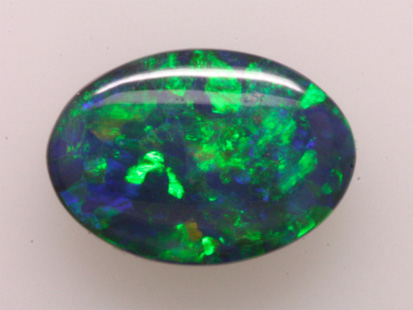
In some types of opal, light is dispersed and diffracted by structures within the opal into patches and streaks of rainbow colors that move and change with the light. This phenomenon is known as play-of-color.
Opal that shows play-of-color is probably the most popular of the phenomenal gems and is sometimes referred to as precious opal-it is certainly the most important commercially. Because opal can be of very high value and shows an extremely wide variety of types, colors, intensities, and patterns, it requires a more complex grading approach than other phenomenal gems--see our pages on grading opals.
Adularescence
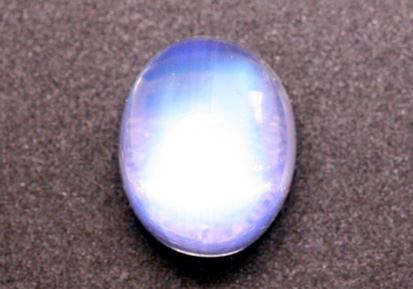
When a gem is displayed under a source of light, this phenomenon, also known as schiller, is a billowy glowing light that emanates from within the gemstone. In moonstones, light interacts with thin transparent alternating layers of orthoclase and albite feldspar within the gem-slight differences in the refractive indexes of the feldspars scatter the light- the thinner the layers, the bluer the sheen.
Moonstones, rose quartz, prehnite, and agate are gems that exhibit adularescence. Moonstone, the finest example, is the most well known and popular, and is usually cut en cabochon, although we also see fine carved examples. Because of its value, full grading applies mainly to moonstone.
Grading Adularescence
We evaluate the strength of the effect and assign a number grade is as follows:
- 5-Very Strong, Very Bright
- 4-Strong, Bright
- 3- Moderate
- 2- Weak
- 1- Faint
Next, we grade the color of the phenomenon by description. Blue and Rainbow are generally ranked as the best sheen colors in moonstone, but rare specimens may exhibit unusual tones including orange. White is the most common color and least valuable.
The orientation of the effect is very important- it should be centered in the middle of the stone at its highest point, so that it is seen at it strongest when the stone is face up.
Lastly, we describe the body color and transparency of the gem. Colorless moonstones that are also highly transparent show their glow to best effect.
Chatoyance
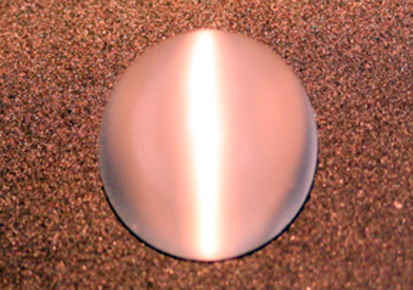
Also known as Cat's Eye, chatoyance is usually caused by minute fibrous inclusions within the stone that are parallel to each other and perpendicular to the length of the stone. When viewed under a spot source of light, the inclusions create a bright and distinct line centered down the length of the stone. The lens-like shape of the cabochon focuses light onto the fibers where it becomes collected and reflected back as the bright line that we call the "eye".
When the stone is rotated in light aimed at the stone from about 45 degrees, the eye will actually open into two distinctly bright sides with a darker center-and It will open and close as we rotate the stone back and forth thru 90 degrees. This dramatic effect is much like what we sometimes see in the iris of a cat, hence the name Cat's Eye.
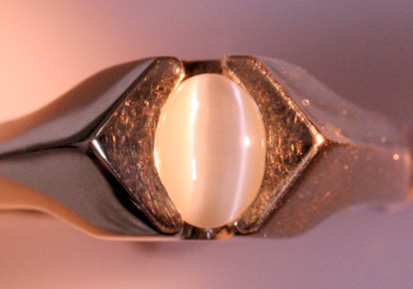
If the spot light is aimed at the gem perpendicular to the length and parallel to the bottom, many chatoyant gems will show a "Milk and Honey" effect, where the side opposite the light source is distinctly brighter than the side closest to the light. The inclusions act like fiber optic glass, carrying the light thru the stone to the side opposite the light.
The classic and generally most valuable Cat's Eye gem is the Chrysoberyl, and the most common and least expensive is the Tiger Eye Quartz. We also see other cat's eye gems including Alexandrite, Aquamarine, Emerald, Tourmaline, Garnet, Diopside, and others, however these are rare and their chatoyance is usually not as defined as in the chrysoberyl cat's eye.
Grading Chatoyance
We grade the sharpness of the eye, it's orientation, whether it's complete and straight, and the Milk and Honey effect, if present, according to the number scale.
- 5-Very Strong, Very Bright
- 4-Strong, Bright
- 3- Moderate
- 2- Weak
- 1- Faint
Generally, the finer the texture of the inclusions, the sharper the eye and the stronger the Milk and Honey effect.
Body color and transparency are the other key factors in the Overall Quality Grade.
Asterism
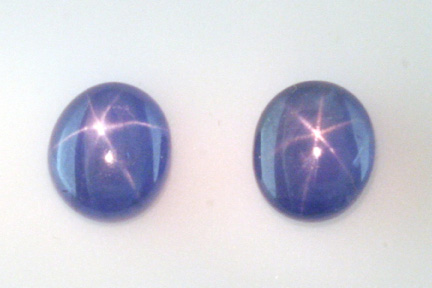
Known as the Star effect, this phenomenon is basically crossed chatoyant bands of light displayed on the highest part of the cabochon. Caused by tiny needle like inclusions that are oriented in several specific directions, the number of "legs" on the star varies with the different gem specie.
Star rubies and sapphires, the most valuable Star stones, normally display 6 legs. Star garnets and diopside/enstatite typically have 4 legs. A good star will follow a spotlight source, but the star should be perfectly centered when the light source is directly overhead.
Occasionally we see gems with double stars, or double the normal number of legs, an effect caused by twinning within the crystal structure of the gem. Both Cat's Eye and Star gems can show multiple eyes or stars under multiple light sources.
Grading Asterism
With star stones, it's very important that the orientation of the star is centered on the high point of the cabochon and that the legs are straight, evenly spaced and complete. Body color and transparency are factors of the Overall Quality Grade.
We apply similar criteria as with Cat's Eyes- the brightness, sharpness, orientation, number and straightness of legs are evaluated, according to our standard scale.
- 5-Very bright, perfectly centered, sharp, straight and complete
- 4- Bright, well centered, mostly straight and complete
- 3- Moderate, slightly off center, less sharp and complete
- 2- Weak
- 1- Faint
Color Change
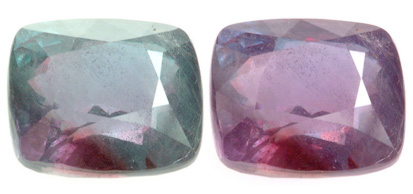
A number of gems actually display a different body color when viewed in different types of light. For example, an alexandrite (color change variety of chrysoberyl seen above) may appear purplish red when seen in incandescent light, but bluish green when seen in daylight.
This phenomenon is caused by selective absorption- light passing thru the gem is "filtered" by a "trap door" in the middle of the spectrum, so that when viewed in light with a warmer color temperature, the gem will be seen on the red side, when seen in light with a cooler color temperature, it will show more green.
The classic color change gem is alexandrite, a variety of chrysoberyl, but sapphire, garnet, and a few other less common gems including diaspore will show color change. The best alexandrite can show perhaps the most dramatic shift, from red to green.
This separation of the colors along the color wheel is very important. A good color change sapphire may go from violetish blue to reddish purple, while a good alexandrite leaps from reddish-purple to bluish-green, hence the alexandrite is much more famous and sought after for its more dramatic color change.
Grading Color Change
Color change gems are graded in incandescent light and then daylight. The degree or strength of the color change is graded as
- Strong
- Moderate
- Weak
If the color change is weak, it will have little effect on the value, while if it is strong, it can greatly increase the value in an otherwise fine and rare gem.
Saturation and Hue
The saturation or intensity of the two colors has a very significant effect on the desirability of the color change gem. Hues like bluish green or blue green to purplish red or purple red are the most desirable.
The colors of alexandrites from Brazil, Russia, and Africa are usually of moderately strong saturation. Extra fine and museum quality specimens may achieve strong hues. The colors in our example above might be described as medium slightly grayish reddish purple or medium grayish bluish-green.
Sri Lanka produces some very large alexandrites with a moderate to strong color change, but also with a noticeable brownish overtone resulting in a change that is less desirable. These brownish looking stones are much less valuable than smaller gems from other locales with brighter colors.
Faceted color change gems are graded for clarity and cut just as are other faceted gems. We combine color change, clarity, and cut to establish an "Overall Quality Grade."
Iridescence / Labradorescence
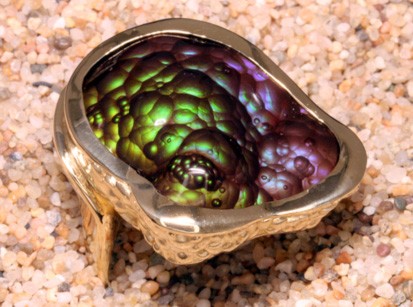
Optical phenomena of rainbow color effects, somewhat like oil on water, are caused by the interference of light by structures within the gem materials. Labradorite, a variety of orthoclase feldspar, fire agate (above), mother of pearl, and iris agate exhibit this phenomenon. The orient of pearls is a related effect. These effects are not usually graded but described according to color, strength, coverage and overall appeal.
Grading Opals
Intro
Play-of-color is an unique optical phenomenon produced by the internal structures of certain opal types that interact with light to create an intense display of spectral colors in patterns that can change and shift dramatically as the stone or viewpoint moves.
Opal with play-of-color is the most beautiful and valuable variety of opal, and is sometimes referred to as "Precious Opal". Play-of-color is the most significant factor in the value of an opal and is graded by brightness, dominant and combined colors, pattern, and coverage/directionality.
Opals, normally cabochon cut, are graded by the same general principles as faceted gems, but call for terminology unique to opal. Opal may be sold by carat weight or by the piece, depending on type and quality.
When we grade opal, we are referring to opal with play-of-color. We grade an opal by first identifying its type.
Quality Grade
We grade the combined effects of brightness, pattern, colors, coverage and directionality, and cut, as well as rarity, with a description and score of 1-10, 10 being best.
Since play-of-color is the dominant feature, we start there and then apply adjustments for cut and polish. Cut is less important in grading opals than for transparent faceted gemstones. So, a stone graded 9 for play-of-color could have only good cut grading and still be considered Extra Fine 9.
- 8 - 10: Extra Fine. The best of the best, rarely seen, and never cheap. Play-of-color is always brilliant, coverage 95%+, usually bright in all directions. Should be an interesting pattern. May have only minor defects in cut. These stones are often truly unique.
- 6 - 8: Fine. Play-of-color is always very bright, some parts brilliant, coverage 90%+, usually bright in most directions. May have minor to slight defects in cut. White base opals usually don't exceed this category.
- 4 - 6: Good. Play-of-color is bright, some parts very, coverage 85%+, may be noticeably directional. May have slight defects in cut, should not be too thin.
- 1 - 4: Stones in this category are what the gem trade calls "commercial". Can include stones with some bright play-of-color, 50-80% coverage, some dull areas face up. Low commercial may be very thin or otherwise poorly cut, dull, 20% coverage, and/or deficient in color.
Opal Type
Opals with play-of-color are generally grouped by type according to body color, background color or structure as follows:
- Black
- Gray
- Crystal
- Semi-crystal
- White
- Water
- Boulder
- Fire-transparent opal from Mexico with yellow to red body color that may or may not have play-of-color.
"Common Opal" has no play-of-color and is usually opaque or translucent rather than transparent. Common Opals can be commercially valuable when they have beautiful delicate body colors. They are generally grouped by their color or country of origin, as in Peruvian blue opal, and are sold based on color, cut craftsmanship, and size.
Brightness
The intensity of the play-of-color in precious opal is rated on the following scale:
- 5: Brilliant. Shows exceptionally bright crisp color under the grading lamp or in indirect sunlight. May show even brighter in subdued light.
- 4: Very bright. Shows good color under low light, sharp crisp color under the grading lamp or in indirect sunlight.
- 3: Bright. Shows fair color under low light, but pleasant and bright under the grading lamp or in indirect sunlight.
- 2: Dull. Shows some color under low light but is dull even under the grading lamp or in indirect sunlight.
- 1: Faint. Play-of-color only under bright light, almost non-existent
Colors
Bright spectrum colors are the most desirable. More pure and vibrant hues are better.
Because play-of-color is directly related to the size of certain structures within the opal, some colors are more rare in nature, red in particular. In top quality stones, certain color combinations are particularly sought after, such as red with blue in black opals.
Colors are generally ranked in order of value as follows:
- Red
- Violet
- Orange
- Yellow
- Blue
- Green
Opal Patterns
Play-of-color patterns in opal are generally described in terms describing the overall look. Many patterns are truly unique and call forth the most poetic and passionate descriptions, however we can group them into three basic types. Many opals display multiple patterns.
-
Pinfire- typically small points or dots of color that cover an area.
- Chaff, Twinkle, Straw, etc.
-
Flash- larger areas of play-of-color that often move or change color with movement.
- Broad Flash, Rolling Flash, Exploding Flash, Ribbon, Rainbow, etc.
-
Harlequin- large distinct usually rectangular patches of play-of-color with edges touching each other. The rarest pattern type.
- Checkerboard, Flag, Fish Scale, Flagstone.
Coverage/Directionality
We estimate the play-of-color coverage of the face up view of the opal as a percentage, 100% being the ideal. Voids and weak or dead spots in the play-of-color can seriously detract from the value of a stone.
We also consider the directionality and consistency of the play-of-color. The strength of play-of-color can change dramatically with viewing angle. Strongly directional stones are generally less desirable. A stone must be consistently bright in all directions to be considered top quality.
Cut
Most opals are cut as cabochons, although some of the more transparent types, especially Fire Opal, may be faceted.
The cut grade generally reflects how well the play-of-color is displayed.
Many opals are cut with the play-of-color positioned in a layer over a base of matrix or colorless material called potch. When the matrix or potch is dark, it can emphasize and show the play-of-color to better advantage, adding value significantly-- seen mainly in black and boulder opals.
Evaluating the shape of an opal is often purely subjective. The general face up rules for proportion govern standard shapes and calibrated commercial material. Baroque stones are graded by overall face up appeal and character as well as for suitability for use in jewelry.
Thickness of material and suitability for setting is an important consideration since opal is a relatively delicate gemstone. Excessive weight retention is a negative.
We grade the cut and polish of an opal individually with the following terms:
- Excellent
- Very Good
- Good
- Fair
- Poor
Enhancements
Many colored gemstones are enhanced to improve their appearance. The American Gem Trade Association (AGTA) has defined the enhancement of gems as "any traditional process, other than cutting and polishing, that improves the appearance (color/clarity/phenomena), durability, or availability of a gemstone." Another term for enhancement is treatment.
For a free and complete description of gemstone enhancements/treatments, please refer to the AGTA website where you can download The Gemstone Information Manual in PDF form.
Many types of enhancement like heat treatment and oil/resin filling are accepted as normal trade practice. Heat treatment is usual for aquamarine, many tourmalines, topazes, quartzes, and rubies and sapphires, and most emeralds are oil/resin treated to some degree.
Some gems, including garnets, peridot, and spinels, are not normally enhanced.
Our Overall Quality Grade may or may not be affected by normal or common enhancements. Example - heat treatment of aquamarine is not detectable by usual lab testing, so even the best aquamarines are assumed to be heat-treated. On the other hand, emeralds must have no treatment or only a minor amount of oil/resin to be graded fine or extra fine.
The Overall Quality Grade (and stone value) is usually substantially higher in untreated gems of high quality because of the added rarity of such material.
Ethical gem dealers have a responsibility to fully disclose any enhancements in the gems they sell. In fact, full disclosure of gem enhancements and treatments is a requirement for our membership in the AGTA.
If a gem we sell is enhanced by any method, it will be disclosed and stated on our grading report and on our sales receipt.
Country of Origin
Some countries are famous for particularly fine gems. Because of the fame and reputation of these gem-producing countries, the gem trade and the buying public will pay more for stones with provenance from these sources. Good examples are sapphires from Kashmir, rubies from Burma, and emeralds from Colombia.
The country of origin is usually ascertained by a gemologist who studies inclusions in the gemstone with a gemological microscope. Sometimes, country of origin can only be accurately determined with high tech laboratory testing. In many cases, country of origin cannot be determined at all.
When certain diagnostic inclusions are present in a gem, they prove that gemstone is from a specific locale. For example, emeralds from Colombia are the only emeralds known to contain three phase inclusions, so when we see a three phase inclusion in an emerald, we know it is from Colombia.
A gem lab report that states country of origin usually accompanies high-end gems, especially those from "classic" locations. Caution--being from a classic source does not guarantee high quality-- the origin report simply states where the gem came from. Quality is shown on grading reports only.
Please note that the reputation of the issuing gem lab is the most important consideration in the purchase of top quality gems where country of origin is a significant consideration. GIA and AGL are two top US labs, while the GRS labs of Switzerland and Thailand are very well respected.
In our opinion, more attention should be paid to the actual merits of a gemstone than to its country of origin. A sapphire from Sri Lanka or Madagascar can be equally or more beautiful than a sapphire documented to be from Kashmir or Burma. Gemstones should always be purchased based on their merits rather than solely on a lab report.
Photography
Notes on Photography: Gemstones and jewelry are notoriously difficult to photograph. We use a Canon EOS digital SLR camera with 100mm and 60 mm f/2.8 Macro lenses, positioned on an ImageDome light stage. The background material in most instances is white matte plastic. We shoot with shutter priority, and a relatively slow shutter speed.
The digital images are minimally edited in Photoshop-usually just Auto Contrast or Auto Adjustment, and cropping to proper size. In some cases, we also adjust the image level to lighten the image, and may use the clone tool to erase dust.
The purpose of the photographs on our website and in our grading reports is to provide accurate information about our gems and jewelry. We make every effort to provide fair and representational photographs.
Please be aware of the limitations of digital photography, computer display screen technology, and of course, the limits of your own perception of color-these affect the way a gemstone or jewelry is perceived. Your decision to purchase a gemstone should not be based solely on photographs.
Our Grading Guarantee
Our grading reports provide our clients with the identity of the gem plus accurate weights and measurements plus a realistic grading of the quality of the gem.
We have made every attempt to correlate our grading with normal gem trading practice and to grade fairly and with discipline- We guarantee our grades to be accurate within the limits of our grading system and put it in writing.
Gem Origins - Wherever possible, we will state country of origin. If we don't know for certain where a gem comes from, our report will state "Not Known".Gem Enhancements - In all cases, we disclose any type of gem enhancement and guarantee that disclosure to be accurate or your money back.




